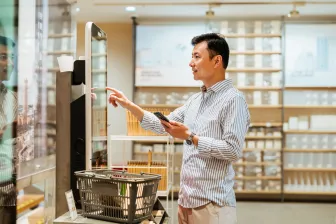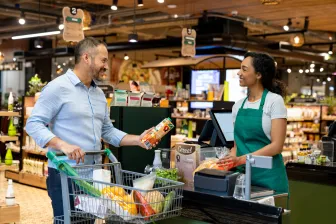New technologies usually crush existing ones; the metal tool supplanted the stone axe, the video tape fell to the DVD, then Blu-Ray and now streaming services. Does the use of COTS devices for payment ring the imminent death knell for the dedicated payment terminal?
To answer the question, we will need a grounding in the use of COTS ("commercial off-the-shelf" devices; that usually refers to phones to you and me). New technologies certainly enable COTS to accept card payments. My colleague, Eddie Black recently wrote an excellent article, ‘A new twist on tap and go’, which elaborates on this matter. However, are the ubiquity and convenience of everyday devices capable of pushing payment terminals off the cliff?
Are COTS devices the payment terminals of the future?
There are four key factors that will sustain the demand for dedicated payment terminals: trust, robustness, monitored infrastructure and universal acceptance:
1. Trust: In our highly connected world, it's easy to fall prey to scams and cyber-crime simply by clicking on a link without thinking. Some of the plays are very sophisticated and even the tech savvy can fall foul. Given the high level of awareness in the population there will be a trust barrier to overcome in asking a customer to tap their card on a phone (rather than a terminal) and an even higher hurdle to enter their PIN on the same phone. The technology is secure, and the PCI Council and card schemes wouldn't be supporting trials of the technology if it wasn’t, but that assurance won't be enough to encourage everyone to overcome their natural reluctance to try something new that may also feel like a financial risk.
2. Robustness: When designing new terminal models, Ingenico goes to great lengths to ensure they will cope with conditions in the field. The components used in a dedicated terminal are designed and built for longevity and reliability and are subject to rigorous testing in laboratory conditions. Devices are tested in climatic chambers to assess their ability to withstand temperature variations, humidity, damp and thermal shocks (hot to cold). Endurance is assessed too, looking at repeated card insertions and magstripe swipes, keyboard durability, cable strength, contactless lens resistance, printer endurance and even the paper roll locking mechanism gets a look in. All these tests are defined and developed by Ingenico in addition to the standard industry tests which look at abrasion and impact.
COTS, on the other hand, are designed to be used as personal electronic devices for communication and productivity. Simply put, the reliability of COTS as a payment device isn't enough to supplant a dedicated terminal in a major retailer doing hundreds or thousands of in-store transactions every day.
3. Monitored infrastructure: The control of payment terminals is critical in ensuring the compliance of an estate. It may sound like a luxury, but a payment-accepting device must be maintained following strict rules:
- Terminals are physically secure and cannot be opened. This protocol is part of the PCI PTS certification which was put in place to prevent hardware fraud. When you force a terminal, it gets locked and must be replaced.
- Regular updates of the payment application (and other applications), device drivers and operating system. This keeps all the device applications up to date with the latest regulations and functionality. Updates are sent to the terminal from a hosted system that we call Terminal Estate Management (TEM) and take place outside normal working hours to avoid impacting business continuity and are mandatory.
For COTS solutions it is likely that the payment application is provided by a third party and delivered to the smartphone from the platform specific app store and can be vetoed. This means they may not be up to date with the latest regulations or functionality which is an unpalatable prospect for a large high street brand.
4. Universal acceptance: The payment terminal is a universal solution that can accept every payment method. The ability to make and accept any type of payment, from anywhere across the world, is essential for today’s business. It increases the volume of transactions for acquirers and expands the customer base for merchants. Consumers can pay the way they wish, be it contactless, via QR Codes or coupons, by a fingerprint scan or facial recognition, through their phone or even through good old-fashioned Chip and PIN.
‘Commercial off-the-shelf’ devices bring great benefits such as ubiquity (all-in-one device), integral customer experience and simplicity of use for merchants. However, the factors mentioned above clearly demonstrate that a payment terminal has features that cannot be offered by a COTS unless… it becomes a payment terminal.
Could a payment terminal offer some of the features of a COTS?
Another perceived threat to the future of the traditional payment terminal is the emergence of Alternative Payments Methods (APMs) which are disrupting the card payment business. QR code systems, crypto-currencies, direct payments through open banking, buy now pay later, e-wallets… all of these can be mediated through consumer and merchant smartphones and as they grow in prevalence the attractiveness of payment acceptance on COTS may grow. Capgemini World Payments Report 2020 predicts a doubling of the use of digital wallets by 2023 and reports that in 2020, 27% of consumers experimented with QR payments and 35% of card holders added these to a digital wallet.
However, dedicated terminals aren’t just for payment with cards and for many years have been a platform to bring other Value Add Services (VAS) to the Point of Sale, for example topping up a pre-pay mobile phone. With increases in the range and popularity of APMs, the payment terminal has increasingly become a secure platform for merchants to accept payments whichever way customers want to pay.
Ignoring Apple, Google and Samsung Pay, which ride on the rails of contactless payments, APMs normally need a specific application or enhancement to the payment application to enable acceptance, so they're not available on all terminals in all territories. However, here are some key examples of APMs which are already accepted on Ingenico’s terminals:
- Blik is an APM for the Polish domestic market that allows the consumer to make payments directly from their bank account, in store or online, by providing a 6-digit code generated dynamically with a smartphone application. The 6 digits can be entered on a Blik enabled payment terminal or at an online checkout.
- Alipay is the dominant APM in the Chinese domestic market. It is driven by an application on a smartphone and uses QR codes as the mechanism to conduct the transaction. It is commonly deployed on Ingenico terminals in China but can also be found on our terminals across Europe, meeting demand from Chinese citizens working and travelling in the region.
- Buy Now Pay Later schemes allow the consumer to take advantage of an interest free, short-term loan to cover low to medium cost items. The sign-up process is normally carried out prior to making payment (off the terminal) and the consumer then selects the relevant scheme offered by the merchant on the payment terminal during checkout. These schemes have received some criticism as providing credit to those who can often least afford it, however, if used appropriately they are cheaper than cards and avoid the vulnerable going to less reputable and unregulated lenders.
Whilst proprietary operating systems have been a barrier to adding some APMs and other VAS to the terminal in the past, Ingenico’s new generation of AXIUM terminals using the proven, popular and easy development environment of Android, will bring their own disruption through an explosion of APMs, VAS and productivity applications on the payment terminal.
Even as new payment methods continue to emerge and other devices begin to accept traditional card payments, the payment terminal will maintain its central role, providing a springboard for innovation and acting as the essential point of trust for consumers at the moment of purchase.











